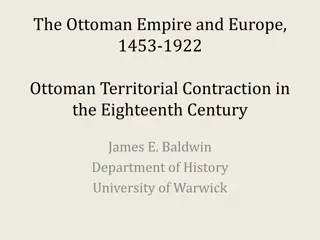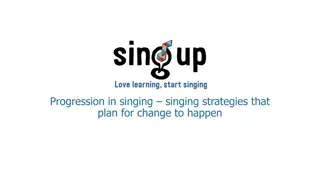Emerging Trends in 21st Century Learning Pedagogies
Higher education faces the challenge of adapting to a changing world at the turn of the 21st century. Innovative learning pedagogies such as distributed cognition, personalization, openness, student-generated content, and interactive learning are key in preparing institutions for future competitiveness. The concept of distributed cognition suggests that cognition is not limited to individual brains but extends to social organizations, reflecting underlying cognitive architectures. This approach emphasizes information sharing and transformations within groups, viewing social organization as a cognitive structure in itself.
Download Presentation

Please find below an Image/Link to download the presentation.
The content on the website is provided AS IS for your information and personal use only. It may not be sold, licensed, or shared on other websites without obtaining consent from the author. Download presentation by click this link. If you encounter any issues during the download, it is possible that the publisher has removed the file from their server.
E N D
Presentation Transcript
21 century learning trends reative Commons License Assoc. prof. dr. Airina Volungevi ien , Prof. dr. Margarita Teresevi ien Dr. Virginija Bortkevi ien , Danut Pranckut Vytautas Magnus University This work is licensed under a Creative Commons Attribution-NonCommercial- ShareAlike 4.0 International License. KA2 Strategic Partnerships 2016-1-HU01-KA202-022916
Innovative learning pedagogies trends On the threshold of the 21stcentury, higher education is faced with the challenge of preparing itself to fulfill its mission adequately in a changing world. As we are moving into the new millennium, there are a number of factors that are affecting institutions of higher institutions approach these challenges will determine whether they will remain competitive in the future, or lose the status which they had held for several centuries. education. How these Resource: Yusep Rosmansyah, Herdi Ashaury, "A 3D multiuser virtual learning environment and learning management system", Electrical Engineering and Informatics (ICEEI) 2017 6th International Conference on, pp. 1-6, 2017, ISSN 2155-6830. KA2 Strategic Partnerships 2016-1-HU01-KA202-022916
Innovative learning pedagogies trends distributed cognition personalisation of learning openness student generated content connected learning interactive learning KA2 Strategic Partnerships 2016-1-HU01-KA202-022916
Distributed cognition approach From the Society of Mind: each brain contains hundreds of different types of machines, interconnected in specific ways which predestine that brain to become a large, diverse society of partially specialized agencies. Implication: the cognition of an individual is also distributed Social organization in a ship: there is a captain, navigators, radio operators, engine engineers, etc., all working to move the ship Resourse: https://pin.it/qv7v57ae644skd KA2 Strategic Partnerships 2016-1-HU01-KA202-022916
Distributed cognition approach Socially Distributed Cognition Anthropologists and sociologists studying knowledge and memory, AI researchers building systems that do distributed problem solving, social psychologists studying small group problem solving, etc., have all arrived at the same idea Social organization is itself a form of cognitive architecture Cognitive processes involve trajectories of information transmission and transformations, so the patterns of these information trajectories reflect some underlying architecture Rationale: Since social organization plus the structure added by the context of activity largely determines which way information flows through a group, then social organization may itself be viewed as a form of cognitive architecture Distributed cognition means more than that processes are socially distributed across members of a group, rather, it encompasses the group members as well as their interactions with other people as well as with their environments Based on: http://www.ics.uci.edu/~kobsa/courses/ICS205/06F/Distributed-Cognition KA2 Strategic Partnerships 2016-1-HU01-KA202-022916
Personalissation of learning What is Personalized Learning? Personalized Learning Active Learning Project-Based Learning Resource: http://slideplayer.com/slide/10675208 KA2 Strategic Partnerships 2016-1-HU01-KA202-022916 6 www.k12blueprint. com
Characteristics of a Personalized Learning Environment Students work to meet standards Students are assessed in multiple ways. Students manage their own learning Students use technology to meet learning goals. Students make choices about what and how they learn Students collaborate with peers and adults. Resource: http://slideplayer.com/slide/10675208 KA2 Strategic Partnerships 2016-1-HU01-KA202-022916
Personalized Learning and Technology Integration Students have access to online resources that enable them to make choices about content. Mobile devices allow students to access resources and complete tasks any time and anywhere. Online tools and apps expand the ways in which students can demonstrate their learning. Working with technology prepares students for life and work in the 21stcentury. Resource: http://slideplayer.com/slide/10675208 KA2 Strategic Partnerships 2016-1-HU01-KA202-022916
Just the Facts about Personalized Learning Fiction Fact Students decide what they want to learn. All students meet standards but make choices in addition to and within those standards. All students work individually on tasks designed for them. Students work with small and large groups, as well as alone. Students participate in a variety of formative and summative tasks, in addition to grades. Students do not receive grades. Students are free to take the easiest path to learning. Self-directed learning and meeting challenges are important components of personalized learning. Resource: http://slideplayer.com/slide/10675208
Benefits of Personalized Learning Support for student-centered instruction Student engagement and ownership Development of 21stcentury skills such as collaboration and self-direction Student interest in and proficiency with technology Access to student data that can drive teaching and learning. Resource: http://slideplayer.com/slide/10675208 KA2 Strategic Partnerships 2016-1-HU01-KA202-022916
Students generated content Student generated content (SGC) promotes a digital learning environment where students are prosumers; that is, both content producers and consumers, co-creating, collaborating and sharing their work with other students. Resource: http://slideplayer.com/slide/10675208 KA2 Strategic Partnerships 2016-1-HU01-KA202-022916
Students generated content Meanwhile, the tutor takes on the role of facilitator encouraging students to search for a deeper understanding of the subject matter via discussion & analysis in seminars. For students, a wide range of cognitive disciplines are needed to successfully filter subject reading material and to identify content useful for: presentation to their peers; peer assessment; and course examination. Resource: http://studentgeneratedcontent.weebly.com KA2 Strategic Partnerships 2016-1-HU01-KA202-022916
Purpose and Benefits of Student Generated Content (SGC) When you have students create, or generate, content you moved them from being consumers to being prosumers (producers + consumers) of content as they create, collaborate, and share with other students and the instructor. The content students create can even be used for future offerings of the course or in real world projects. The benefits of SGC for your students are far reaching and valuable: move them from watching or reading content (passive) to creating it (active), ensuring better content retention and richer understanding give students ownership over their learning provide real world audiences and applications for their work allow them to produce work of lasting value help them build project management skills Resource: http://www.css.edu/administration/information-technologies/academic-technology-and-online- learning/teaching-guide/student-generated-content.html KA2 Strategic Partnerships 2016-1-HU01-KA202-022916
Connected learning Interactive incorporates social networking and urban computing into course design and delivery. Interactive Learning has evolved out of the hyper-growth in the use of digital technology and virtual communication, particularly by students. The use of interactive technology in learning for these students is as natural as using a pencil and paper were to past generations. Learning is a pedagogical approach that Resource: https://en.wikipedia.org/wiki/Interactive_Learning KA2 Strategic Partnerships 2016-1-HU01-KA202-022916
Why Connect? A. Because connection underpins basic communication B. Because we are curious beings C. Because it allows us to expand boundaries D. Because technology affords us the ability to connect E. All of the above Other reasons to connect? Rise you questions for discussion! Resource: https://library.educause.edu/~/media/files/library/2013/4/live1308-pptx.pptx KA2 Strategic Partnerships 2016-1-HU01-KA202-022916
Always on Devices Previous devices when used by people Current devices in preparation of being used by people Future user less device connections Resource: https://ecoosfera.com/2012/09/lifx-bulb-el-foco-eco- amigable-que-dura-mas-de-20-anos-y-cambia-de-color/ Resource: https://www.digitaltrends.com/home/demoing-the-app- controlled-samsung-smart-washer-and-dryer KA2 Strategic Partnerships 2016-1-HU01-KA202-022916
Connected Learning Framework Resource: https://clrn.dmlhub.net 1. 2. 3. Values Learning Principles Design Principles Ito et al, 2013 KA2 Strategic Partnerships 2016-1-HU01-KA202-022916
Connected Learning Values Equity Full participation Social Connection KA2 Strategic Partnerships 2016-1-HU01-KA202-022916
Connected Learning Principles Interest-powered Peer-supported Academically oriented Resource: Ito et al., Connected Learning, 63. Based on: https://youtu.be/zFdzz26g-EE KA2 Strategic Partnerships 2016-1-HU01-KA202-022916
Learning Connections Examples 1. Reality Ends Here: USC School of Cinematic Arts Card Game Traditional vs. Online Learning Environments 2. KA2 Strategic Partnerships 2016-1-HU01-KA202-022916
References Yusep Rosmansyah, Herdi Ashaury, "A 3D multiuser virtual learning environment and learning management system", Electrical Engineering and Informatics (ICEEI) 2017 6th International Conference on, pp. 1-6, 2017, ISSN 2155-6830. A. Anderson, Andras Pellionisz, Edward Rosenfeld, Neurocomputing 2: Directions for Research http://www.ics.uci.edu/~kobsa/courses/ICS205/06F/Distributed-Cognition http://slideplayer.com/slide/10675208 http://studentgeneratedcontent.weebly.com http://www.css.edu/administration/information-technologies/academic-technology-and- online-learning/teaching-guide/student-generated-content.html https://en.wikipedia.org/wiki/Interactive_Learning https://library.educause.edu/~/media/files/library/2013/4/live1308-pptx.pptx https://clrn.dmlhub.net https://youtu.be/zFdzz26g-EE KA2 Strategic Partnerships 2016-1-HU01-KA202-022916










































